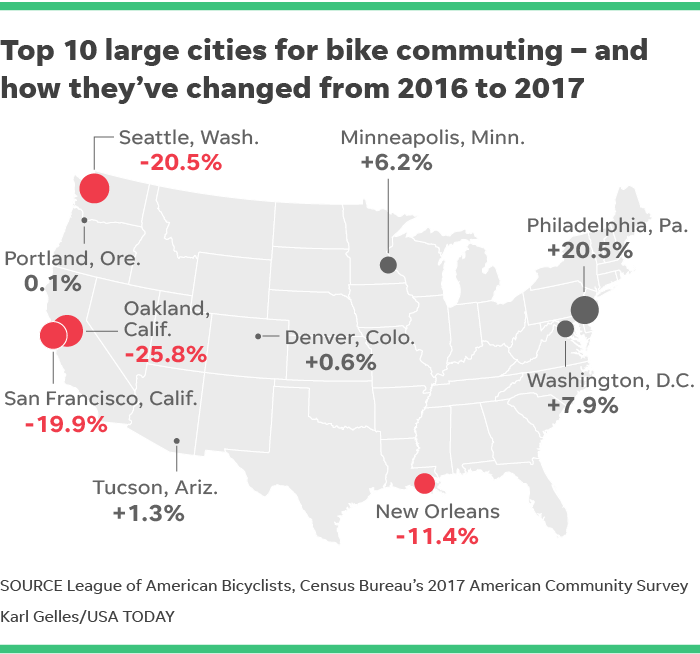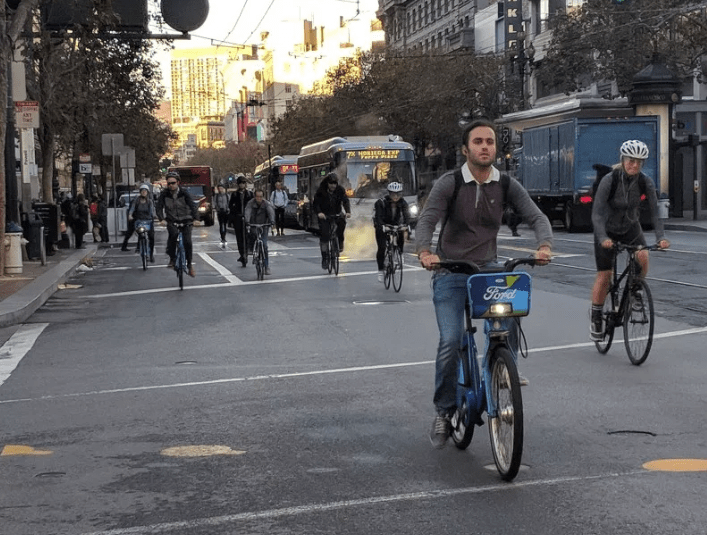Note: GJEL Accident Attorneys regularly sponsors coverage on Streetsblog San Francisco and Streetsblog California. Unless noted in the story, GJEL Accident Attorneys is not consulted for the content or editorial direction of the sponsored content.
"There are three kinds of lies: lies, damned lies, and statistics."... popularized by Mark Twain.
That quote is used to describe how people often massage statistics to support an idea or to prove a point.
A recent article in USA Today, entitled 'Fewer Americans bike to work despite new trails, lanes and bicycle share programs' suggests that, well, fewer people are commuting to work by bike despite all the efforts to improve infrastructure and make it easier. Although it's about the country as a whole, one bit of data raised eyebrows in the Bay Area: the claim that from 2016 to 2017 commuter cycling dropped 19.9 percent in San Francisco and 25.8 percent in Oakland.
Here's the chart they published with the article:

As seen in the caption, the chart attributes the data to the Census Bureau American Community Survey, via the League of American Bicyclists.
So how did USA Today come up with such significant drops?
Chris Woodyard, the writer of the article, confirmed that he got the numbers from the League and not from the source census data. We have an email and a call out to the League.
[UPDATE: The League confirmed (Streetsblog missed an email from them this morning... sorry League!) that they provided the numbers. Streetsblog is trying to find out how they calculated such high drops from 2016-2017]
In the meantime, the San Francisco Bicycle Coalition pointed us to the source data, from the census bureau, which is available online.
Perhaps a math-savvy Streetsblog reader can double check us, but going by the source data, well, there has been a decline in commuter cycling, but it isn't 19.9 percent or anywhere near it. To get to the original data, go to US Census: https://factfinder.census.gov and then search S.F. or Oakland, and then the commute data is under the "business and industry" tab.
Here are numbers we pulled and crunched directly from the census data:
- U.S. Census figures for 2017 show the commuting population of San Francisco at 495,315. It shows the cycling rate at 3.9 percent.
- Multiply 495,315 by 3.9 percent to get the total number of people cycling to and from work. That comes to 19,317.285 people bicycling to work on average in S.F. in 2017.
- U.S. Census figures for 2016 show the commuting population of San Francisco at 479,139. It shows the cycling rate at 4.1 percent.
- Multiply 479,139 by 4.1 percent to get the total number of people cycling to work. That comes to 19,644.699 people bicycling to work on average in S.F. in 2016.
- Okay. The decline from 2016 to 2017 comes to 327.414.
- Percentage decrease = decrease/the original number × 100.
- So, take 327.414/19,644.699
...and that decline comes to 1.7 percent.
Maybe USA Today (or the League) was just talking about the decline per capita? That still only comes to about 5 percent for San Francisco. The chart shows an even more impressive decline for Oakland, at 25.8 percent. In reality, the decline was from 3.1 percent of commute trips in Oakland to 2.9 percent from 2016 to 2017.
[UPDATE, Mon. Jan. 7: In a follow-up email, the League explained that the discrepancy is because the figures above are for 5-year *estimates*, and they used a set of numbers for single-year estimates.]
Of course, if cycling is actually down both in real terms and per capita, that's cause for concern. Some people turn away from cycling, no doubt, because of "...the very real safety concerns that people who bike continue to face on our streets," wrote the SFBC's Brian Wiedenmeier, in an email to Streetsblog. Much of the progress in getting bike lanes striped on city streets has been annulled by the rise of Lyft and Uber, whose drivers park with impunity on the bike lanes, rendering them useless. "As tens of thousands of additional Lyft and Uber vehicles continue to flood San Francisco daily, the need for separate, protected infrastructure has never been greater."
In other words, despite the assertions in USA Today's article, it's unclear from the survey data if cycling really is down at all. And if it is, it probably isn't by much.





